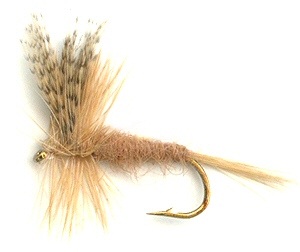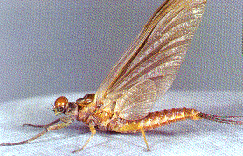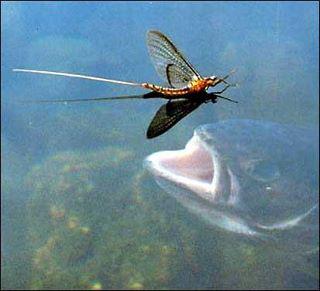The Light Hendrickson Dry Fly
The original Light Hendrickson was tied to represent the female dun of the North American Ephemerella subvaria. This was an insect with a huge horrible Latin name. Such was the success of the artificial fly that the natural insect gained a new common name "The Hendrickson".

DRY FLY PATTERNS. Hook size 12 14 16 18 20 24 - $US each
The dark and light Hendrickson flies are good general mayfly dun imitation patterns. Choose the hook size and color to match your local hatch. Back in 1915 Albert Everett Hendrickson of Scarsdale, NY, USA wrote to Roy Steenrod, about tying a fly to match the dark North American up-winged dun mayfly Ephemerella subvaria. Roy lived in Liberty, NY and fished the Beaver Kill, Esopus, Nerversink and Willowemoc rivers. Albert was invited to accompany Roy on some fishing trips. One day in 1916 whilst fishing on the Beaver Kill river below the junction pool at Roscoe, a hatch of flies came on. They had never seen the fish rise so freely for any fly as they did for this hatch.
Roy caught one of the insects and put it in his fly box and tied a fly to match. They tried it out after lunch. they took fish after fish with this new fly pattern day after day. Two days after the fly was first tied the matter was brought up as to what to call this killer pattern. Roy named it after his new fishing friend and it has been known as the Hendrickson ever since. (Please note that there is a dispute over who originally tied them as some credit Art Flick though I favor the above story because Art Flick was born in 1904 which would have made him only 12 in 1916). These flies are used all over the USA but is not well known outside North America. This is a shame as I have found them both to be a very productive fly in British and European waters for imitating iron blue duns.
The decision on what fly to tie on depends on the type of water you are fishing. If the natural light Hendrickson duns are hatching near riffles and pocket water then I would choose the standard dry fly as the collar hackle gives good floatation and its high silhouette makes it easy to see. They also work on flat water and in light riffles, but you should also consider using low floating flies like a parachute, Klinkhammer or Shipman’s buzzer as they also present a lifelike silhouette to the upward looking hungry trout

You can imitate this mayfly with a Light Hendrickson dry fly pattern
When Light Hendrickson duns are drifting on the surface after hatching, waiting for their wings to dry and harden before making their first flight, you want to use a leader that fits fishing conditions. I find a 7 – 8 foot leader with a 2 foot tippet of 5X or 6X works well during windy conditions on streams that have a lot of riffles and pocket water. On rivers with larger runs and flats, or on streams where the trout are wary, I will use a longer 9 – 12 foot leader combined with a 3 – 4 foot tippet of 6X to 7X. A soft tippet is better at producing a drag free drift and allows the fly to move more freely in micro-currents. Remember to inspect your tippet regularly and replace it when you detect any knots, abrasions or twists that can weaken the line.
On rough water or smaller streams use a short leader and tippet. You can often get close to feeding trout by wading quietly into position and keeping low. You can use the rod to help control the drift by carefully mending the line across currents of different speeds or around obstacles. To reduce the chance of spooking fish with a flashing fly line it is important that your false casts go behind or off to the side of your target trout’s position.
If you spot rising trout feeding on emerging Hendrickson duns use a 6X tippet 3-4 feet in length. Aim to softly drop the fly 6 inches in front of the trout. Let the fly drift 3-4 feet past the trout’s nose before repeating the cast. If you roughly slap the tippet and dry fly on the water surface the trout will spook. Practice again and again until you are proficient at producing gentle deliveries if you want to get good results. If you do not live near water this is something you can do in your local park. The dog walkers will think you are mad but take no notice of them. Place a Frisbee at different distances away from you and try to cast your fly into the disc without it making a noise. Once you have perfected this skill you will be able to really enjoy your next fly fishing trip.

A trout about to eat a Light Hendrickson Mayfly
The Hendrickson is a great attracter pattern. It can be about as deadly as the all year around Adams Dry Fly. An attracter pattern is designed to stimulate a predatory fish's aggression. They do not try to imitate the fish's food. They just provoke a predatory attack response. Although these flies were designed to imitate a certain insect they can be used in areas and at times of the year when that fly is not present. Try a Hendrickson when all logic says it shouldn't work. Use it as an attractor, something different that will catch a trout's hungry eye. It is a fly that has saved the day for me many a time when the fish were not rising for anything I cast to them. This is a pattern that every fly box should not be without.
The Cinygmula mayfly also known as the dark red quill, blue-winged red quill mayfly are normally found in small rivers and creeks rather than tiny streams, although I did once stumble upon a significant hatch on a stream leading into Oregon’s Metolius River. I use a Light Hendrickson dry fly on a hook size 14 or 16 to imitate the duns floating in the surface film as they emerge and wait for their wings to dry before flying off. I cast upstream of a trout feeding area and let the fly dead drift over that area. I left the fly drift past the feeding trout before taking up the line to make another cast so as not to spook them.
The duns have a light red-brown body with a tan coloured wing. The body is a lighter color underneath which is why the Light Hendrickson fools the upward looking fish but looks wrong to the downward looking fly fisherman. They will hatch in moderate to fast runs. I have also had success using an Adams dry fly during a Cinygmula hatch.
A Pheasant Tail nymph or a Gold Ribbed Hares Ear nymph are good choices to use as droppers under a floating Light Hendrickson Dry Fly floating in the surface film. The Cinygmula nymphs are clinger mayfly nymphs. They do not swim like other nymphs that change locations to hunt for food. These nymphs search amongst the debris and vegetation on the bottom of the river to find food. They only become fish food an hour before during and after a hatch except in the rear circumstances when they are ripped from the bottom by an extra strong burst of current during a spate.


Fly Fishing books

